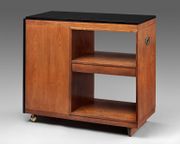Difference between revisions of "Formica"
| Line 1: | Line 1: | ||
[[File:formica black.jpg|thumb|'''MFA Acc. #:''' 93.1108]] | [[File:formica black.jpg|thumb|'''MFA Acc. #:''' 93.1108]] | ||
== Description == | == Description == | ||
| − | + | [[File: Formica white.jpg|thumb|white Formica Counter]] | |
[Formica Corp.] A registered trademark for a series of laminated surfacing materials made from phenolic resins. Formica® was invented in 1912 by Daniel J. O'Conor. Patented in 1913, it was originally made as a substitute for mica, hence its name, and sold to electrical companies as insulation. In 1927, a printing technique was patented to make laminates with decorative surfaces. Formica® laminate and Formica® ColorCore surfacing materials are made from kraft paper impregnated with phenolic and melamine resins then consolidated at high pressures. The sheets are rigid with a uniform thickness. Formica® laminates are designed for interior use on countertops and cabinet facings. The manufacturer recommends that it only be adhered to fiberboard with a Formica® brand adhesive. While top surfaces of an adhered Formica® laminate are resistant to boiling water, an exposed board may warp in high humidity. Freshly cut surfaces will emit small amounts of formaldehyde. | [Formica Corp.] A registered trademark for a series of laminated surfacing materials made from phenolic resins. Formica® was invented in 1912 by Daniel J. O'Conor. Patented in 1913, it was originally made as a substitute for mica, hence its name, and sold to electrical companies as insulation. In 1927, a printing technique was patented to make laminates with decorative surfaces. Formica® laminate and Formica® ColorCore surfacing materials are made from kraft paper impregnated with phenolic and melamine resins then consolidated at high pressures. The sheets are rigid with a uniform thickness. Formica® laminates are designed for interior use on countertops and cabinet facings. The manufacturer recommends that it only be adhered to fiberboard with a Formica® brand adhesive. While top surfaces of an adhered Formica® laminate are resistant to boiling water, an exposed board may warp in high humidity. Freshly cut surfaces will emit small amounts of formaldehyde. | ||
| Line 8: | Line 8: | ||
fórmica (Port.); Arborite (similar product made in Canada) | fórmica (Port.); Arborite (similar product made in Canada) | ||
| − | |||
| − | |||
== Risks == | == Risks == | ||
| − | + | * Possible decomposition products are: carbon monoxide, carbon dioxide, ammonia, formaldehyde and nitrogen oxides. | |
| − | Formica Corporation: [[file:///C:/Users/Michele/Downloads/Intentek%20Safety%20Data%20Sheet%20(1).pdf Safety Data Sheet]] | + | * Formica Corporation: [[file:///C:/Users/Michele/Downloads/Intentek%20Safety%20Data%20Sheet%20(1).pdf Safety Data Sheet]] |
== Physical and Chemical Properties == | == Physical and Chemical Properties == | ||
| Line 18: | Line 16: | ||
Strong acids and alkalis will destroy surface appearance. | Strong acids and alkalis will destroy surface appearance. | ||
| − | == | + | == Resources and Citations == |
| − | |||
| − | |||
| − | |||
| − | |||
| − | |||
| − | |||
| − | + | * Formica: [http://www.formica.com Website]: | |
| − | * Wikipedia, | + | * Wikipedia,: http://en.wikipedia.org/wiki/Formica_%28plastic%29 (Accessed Feb. 10, 2006) |
* Richard S. Lewis, ''Hawley's Condensed Chemical Dictionary'', Van Nostrand Reinhold, New York, 10th ed., 1993 | * Richard S. Lewis, ''Hawley's Condensed Chemical Dictionary'', Van Nostrand Reinhold, New York, 10th ed., 1993 | ||
| Line 42: | Line 34: | ||
* Art and Architecture Thesaurus Online, http://www.getty.edu/research/tools/vocabulary/aat/, J. Paul Getty Trust, Los Angeles, 2000 | * Art and Architecture Thesaurus Online, http://www.getty.edu/research/tools/vocabulary/aat/, J. Paul Getty Trust, Los Angeles, 2000 | ||
| − | |||
[[Category:Materials database]] | [[Category:Materials database]] | ||
Revision as of 15:18, 24 November 2020
Description
[Formica Corp.] A registered trademark for a series of laminated surfacing materials made from phenolic resins. Formica® was invented in 1912 by Daniel J. O'Conor. Patented in 1913, it was originally made as a substitute for mica, hence its name, and sold to electrical companies as insulation. In 1927, a printing technique was patented to make laminates with decorative surfaces. Formica® laminate and Formica® ColorCore surfacing materials are made from kraft paper impregnated with phenolic and melamine resins then consolidated at high pressures. The sheets are rigid with a uniform thickness. Formica® laminates are designed for interior use on countertops and cabinet facings. The manufacturer recommends that it only be adhered to fiberboard with a Formica® brand adhesive. While top surfaces of an adhered Formica® laminate are resistant to boiling water, an exposed board may warp in high humidity. Freshly cut surfaces will emit small amounts of formaldehyde.
Synonyms and Related Terms
fórmica (Port.); Arborite (similar product made in Canada)
Risks
- Possible decomposition products are: carbon monoxide, carbon dioxide, ammonia, formaldehyde and nitrogen oxides.
- Formica Corporation: [Safety Data Sheet]
Physical and Chemical Properties
Strong acids and alkalis will destroy surface appearance.
Resources and Citations
- Formica: Website:
- Wikipedia,: http://en.wikipedia.org/wiki/Formica_%28plastic%29 (Accessed Feb. 10, 2006)
- Richard S. Lewis, Hawley's Condensed Chemical Dictionary, Van Nostrand Reinhold, New York, 10th ed., 1993
- G.S.Brady, Materials Handbook, McGraw-Hill Book Co., New York, 1971 Comment: p. 792
- Ralph Mayer, A Dictionary of Art Terms and Techniques, Harper and Row Publishers, New York, 1969 (also 1945 printing)
- Dictionary of Building Preservation, Ward Bucher, ed., John Wiley & Sons, Inc., New York City, 1996
- Pam Hatchfield, Pollutants in the Museum Environment, Archetype Press, London, 2002
- Art and Architecture Thesaurus Online, http://www.getty.edu/research/tools/vocabulary/aat/, J. Paul Getty Trust, Los Angeles, 2000

